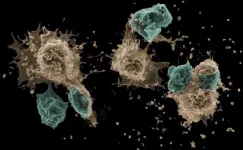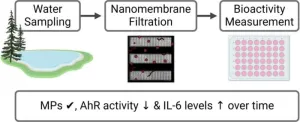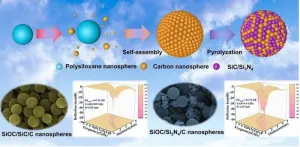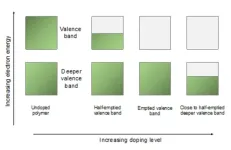Mast cells trap and use living neutrophils during allergic reactions
Allergy Cells’ Hidden Secret
2024-08-02
(Press-News.org) Inflammation is the body's response to harmful stimuli, characterized by heat, pain, redness, swelling, and loss of tissue function. When balanced, inflammation protects the body by clearing harmful agents and initiating tissue repair. However, excessive inflammation can cause tissue destruction and disease. Key players in this process are various immune cells, which work together during inflammation. The type of immune cells involved often varies depending on the harmful stimulus, influencing the outcome of the inflammatory response.
Immune cell trapping during allergic responses
Mast cells, residing in tissues and critical for initiating inflammation, are filled with granules containing pro-inflammatory substances. These granules are released upon encountering potential dangers, including allergens, causing allergic reactions. In many people, mast cells also react to seemingly harmless environmental factors, which then act as allergens and cause allergies. The interaction between mast cells and other immune cells at sites of allergic responses has been largely unexplored.
A research group at the MPI of Immunobiology and Epigenetics used specialized microscopy to visualize the real-time dynamics of activated mast cells and other cell types during allergic reactions in living mouse tissues. Led by Tim Lämmermann, since October 2023 Director at the Institute of Medical Biochemistry at the University of Münster, the team discovered a surprising interaction: neutrophils were found inside mast cells. “We could hardly believe our eyes: living neutrophils were sitting inside living mast cells. This phenomenon was completely unexpected and probably would not have been discovered in experiments outside a living organism and highlights the power of intravital microscopy”, says Tim Lämmermann.
Pulling a neutrophil trick to trap neutrophils
Neutrophils are frontline defenders of our immune system, responding quickly and broadly to potential threats. They circulate in the blood and quickly exit blood vessels at sites of inflammation. They are well-equipped to combat invaders such as bacteria or fungi by engulfing the invaders, releasing antimicrobial substances, or forming web-like traps known as »neutrophil extracellular traps«. Additionally, neutrophils can communicate with each other and form cell swarms to combine their individual functions for the protection of healthy tissue. While much is known about neutrophils’ role in infections and sterile injuries, their role in inflammation caused by allergic reactions is less understood.
“It quickly became clear that the double-pack immune cells were no mere coincidence. We wanted to understand how mast cells trap their colleagues and why they do it,” explains Michael Mihlan, first and co-corresponding author of the study published in the journal Cell. Once the team was able to mimic the neutrophil trapping observed in living tissue in cell culture, they we were able to identify the molecular pathways involved in this process. The researchers found that mast cells release leukotriene B4, a substance commonly used by neutrophils to initiate their own swarming behavior.
By secreting this substance, mast cells attract neutrophils. Once the neutrophils are close enough, mast cells engulf them into a vacuole, forming a cell-in-cell structure that the researchers refer to as »mast cell intracellular trap« (MIT). “It is ironic that neutrophils, which create web-like traps made of DNA and histones to capture microbes during infections, are now trapped themselves by mast cells under allergic conditions,” says Tim Lämmermann.
Recycled neutrophils to boost mast cell function
With the help of an international team, the researchers confirmed the formation of MITs in human samples and investigated the fate of the two cell types involved after trapping. They found that trapped neutrophils eventually die, and their remains get stored inside mast cells. “This is where the story takes an unexpected turn. Mast cells can recycle the material from the neutrophils to boost their own function and metabolism. In addition, mast cells can release the newly acquired neutrophil components in a delayed manner, triggering additional immune responses and helping to sustain inflammation and immune defense”, says Michael Mihlan.
“This new understanding of how mast cells and neutrophils work together adds a whole new layer to our knowledge of allergic reactions and inflammation. It shows that mast cells can use neutrophils to boost their own capabilities – an aspect that could have implications for chronic allergic conditions where inflammation occurs repeatedly,” says Tim Lämmermann. The researchers have already begun investigating this interaction in mast cell-mediated inflammatory diseases in humans, exploring whether this discovery could lead to new approaches to treating allergies and inflammatory diseases.
TL/MR
END
[Attachments] See images for this press release:

ELSE PRESS RELEASES FROM THIS DATE:
2024-08-02
A new USC study suggests that publicly insured individuals who are most likely to benefit from new drugs for diabetes and obesity are less likely to get them than those with private insurance.
Prescription fills for the drug best known as Ozempic or Wegovy — semaglutide — increased by more than 400% between January 2021 and December 2023, according to research out today in JAMA Health Forum.
Approved first for type 2 diabetes, then for weight loss, studies show that semaglutide also improves blood pressure and reduces cardiovascular disease — problems that plague millions of Americans. Yet the lion’s share of prescriptions ...
2024-08-02
A new study reveals the bioactivity of microplastics in Lake Ontario using cutting-edge nanomembrane filtering technology. Researchers found all samples contained microplastics ranging between 8 and 20 µm. The study highlights varying bioactivity levels, such as aryl hydrocarbon receptor (AhR) activity and IL-6 levels, indicating potential health risks. These findings underscore the urgent need for further research to comprehend the impact of microplastics on human health and the environment. This pioneering approach offers fresh insights into tackling the challenges posed by microplastic pollution.
Microplastics ...
2024-08-02
The origins of life remain a major mystery. How were complex molecules able to form and remain intact for prolonged periods without disintegrating? A team at ORIGINS, a Munich-based Cluster of Excellence, has demonstrated a mechanism that could have enabled the first RNA molecules to stabilize in the primordial soup. When two RNA strands combine, their stability and lifespan increase significantly.
In all likelihood, life on Earth began in water, perhaps in a tide pool that was cut off from seawater at low tide but flooded by waves at high tide. Over billions of years, complex molecules like DNA, RNA and proteins ...
2024-08-02
Why does the universe contain matter and (virtually) no antimatter? The BASE international research collaboration at the European Organisation for Nuclear Research (CERN) in Geneva, headed by Professor Dr Stefan Ulmer from Heinrich Heine University Düsseldorf (HHU), has achieved an experimental breakthrough in this context. It can contribute to measuring the mass and magnetic moment of antiprotons more precisely than ever before – and thus identify possible matter-antimatter asymmetries. BASE has developed a trap, which can cool individual antiprotons much more rapidly ...
2024-08-02
The proliferation of concrete infrastructure worldwide has been met with growing concerns over its durability and safety. Concrete structures are increasingly subjected to dynamic forces from natural disasters like earthquakes and environmental degradation, such as corrosion. These factors, coupled with the saturation of infrastructure projects, amplify the risks associated with structural failure. Consequently, there is a pressing need for effective structural health monitoring (SHM) systems that can preemptively identify and address these vulnerabilities. The ...
2024-08-02
In recent years, microwave technology has dramatically progressed, marked by the arrival of the 5G era, owing to the advantages of electromagnetic waves in long-distance, wireless, and high-speed transmissions. However, electromagnetic wave pollution problems such as electromagnetic wave interference and electromagnetic wave radiation are becoming increasingly serious. Electromagnetic wave pollution not only affects the normal operation of electronic equipment, greatly threatens the information security of the scientific community, but also endangers human health and is a possible cause of cancer ...
2024-08-02
NEW YORK CITY, August 2, 2024 — According to American Heart Association data, nine out of every ten people who experience cardiac arrest outside of a hospital die, in part because they do not receive immediate CPR more than half of the time. CPR, especially if performed immediately, can double or triple a person’s chance of survival. That is why the American Heart Association and the National Women’s Soccer League (NWSL) brought cardiopulmonary resuscitation (CPR) and automated external defibrillator (AED) training to NWSL staff at the New York headquarters office located on Madison ...
2024-08-02
Cavendish physicists have discovered two new ways to improve organic semiconductors. They found a way to remove more electrons from the material than previously possible and used unexpected properties in an environment known as the non-equilibrium state, boosting its performance for use in electronic devices.
“We really wanted to hit the nail and figure out what is happening when you heavily dope polymer semiconductors,’ said Dr Dionisius Tjhe, Postdoctoral Research Associate at the Cavendish Laboratory. Doping is the process of removing or adding electrons into a semiconductor, increasing its ability to ...
2024-08-02
Housing policies may be becoming more pet inclusive, but housing insecurity is getting worse, finds a new study that examined the housing issues that led to owners turning their pets over to an animal shelter.
“Over the duration of the study, instances of animals entering shelters due to loss of housing rose, while those due to pet restrictions and landlord conflicts declined,” said the study’s lead author Jennifer Applebaum, Ph.D., an assistant professor in the Department of Environmental and Global Health in the University ...
2024-08-02
Eye-tracking allows studying aspects that cannot be seen, for example, the thinking processes of a student solving a mathematical problem. Researchers at Kaunas University of Technology (KTU) are the first in Lithuania to integrate eye-tracking into education and are using the technology to radically improve the teaching of mathematics.
Eye-tracking creates the possibility for researchers to observe a subject’s attention shifts based on where they fix their gaze or how they move it. This helps researchers understand various emotional, thinking and cognitive processes that happen in response to the environment.
“By applying this technology in mathematical education, ...
LAST 30 PRESS RELEASES:
[Press-News.org] Mast cells trap and use living neutrophils during allergic reactions
Allergy Cells’ Hidden Secret





